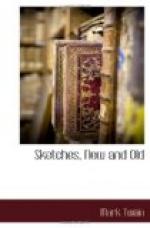Now Professor Field-Mouse having placed his sensitive ear to the tree, detected a rich, harmonious sound issuing from it. This surprising thing was tested and enjoyed by each scholar in turn, and great was the gladness and astonishment of all. Professor Woodlouse was requested to add to and extend the tree’s name so as to make it suggest the musical quality it possessed—which he did, furnishing the addition Anthem Singer, done into the Mastodon tongue.
By this time Professor Snail was making some telescopic inspections. He discovered a great number of these trees, extending in a single rank, with wide intervals between, as far as his instrument would carry, both southward and northward. He also presently discovered that all these trees were bound together, near their tops, by fourteen great ropes, one above another, which ropes were continuous, from tree to tree, as far as his vision could reach. This was surprising. Chief Engineer Spider ran aloft and soon reported that these ropes were simply a web hung thereby some colossal member of his own species, for he could see its prey dangling here and there from the strands, in the shape of mighty shreds and rags that had a woven look about their texture and were no doubt the discarded skins of prodigious insects which had been caught and eaten. And then he ran along one of the ropes to make a closer inspection, but felt a smart sudden burn on the soles of his feet, accompanied by a paralyzing shock, wherefore he let go and swung himself to the earth by a thread of his own spinning, and advised all to hurry at once to camp, lest the monster should appear and get as much interested in the savants as they were in him and his works. So they departed with speed, making notes about the gigantic web as they went. And that evening the naturalist of the expedition built a beautiful model of the colossal spider, having no need to see it in order to do this, because he had picked up a fragment of its vertebra by the tree, and so knew exactly what the creature looked like and what its habits and its preferences were by this simple evidence alone. He built it with a tail, teeth, fourteen legs, and a snout, and said it ate grass, cattle, pebbles, and dirt with equal enthusiasm. This animal was regarded as a very precious addition to science. It was hoped a dead one might be found to stuff. Professor Woodlouse thought that he and his brother scholars, by lying hid and being quiet, might maybe catch a live one. He was advised to try it. Which was all the attention that was paid to his suggestion. The conference ended with the naming the monster after the naturalist, since he, after God, had created it.
“And improved it, mayhap,” muttered the Tumble-Bug, who was intruding again, according to his idle custom and his unappeasable curiosity.
END OF PART FIRST
SOME LEARNED FABLES FOR GOOD OLD BOYS AND GIRLS




